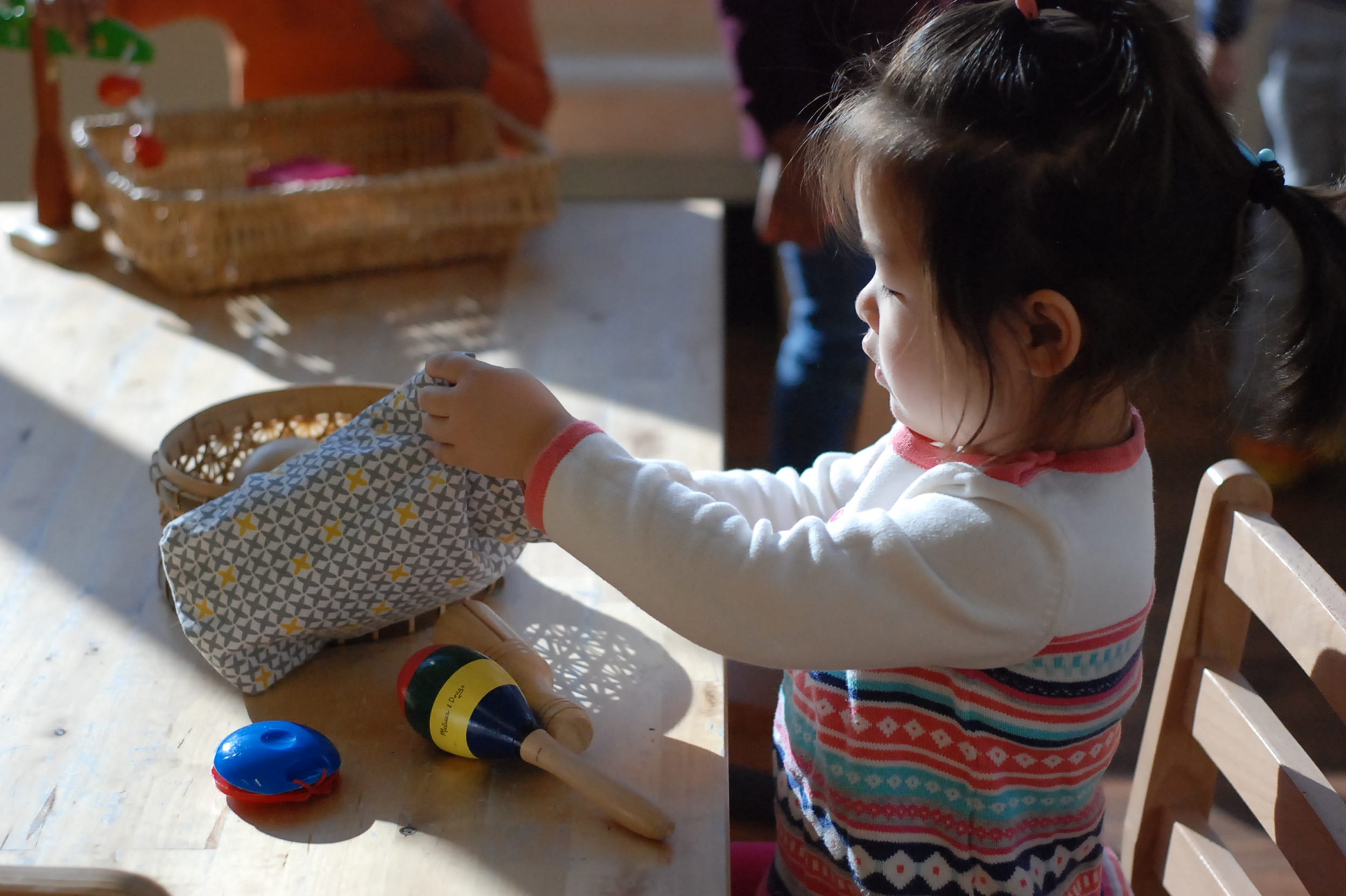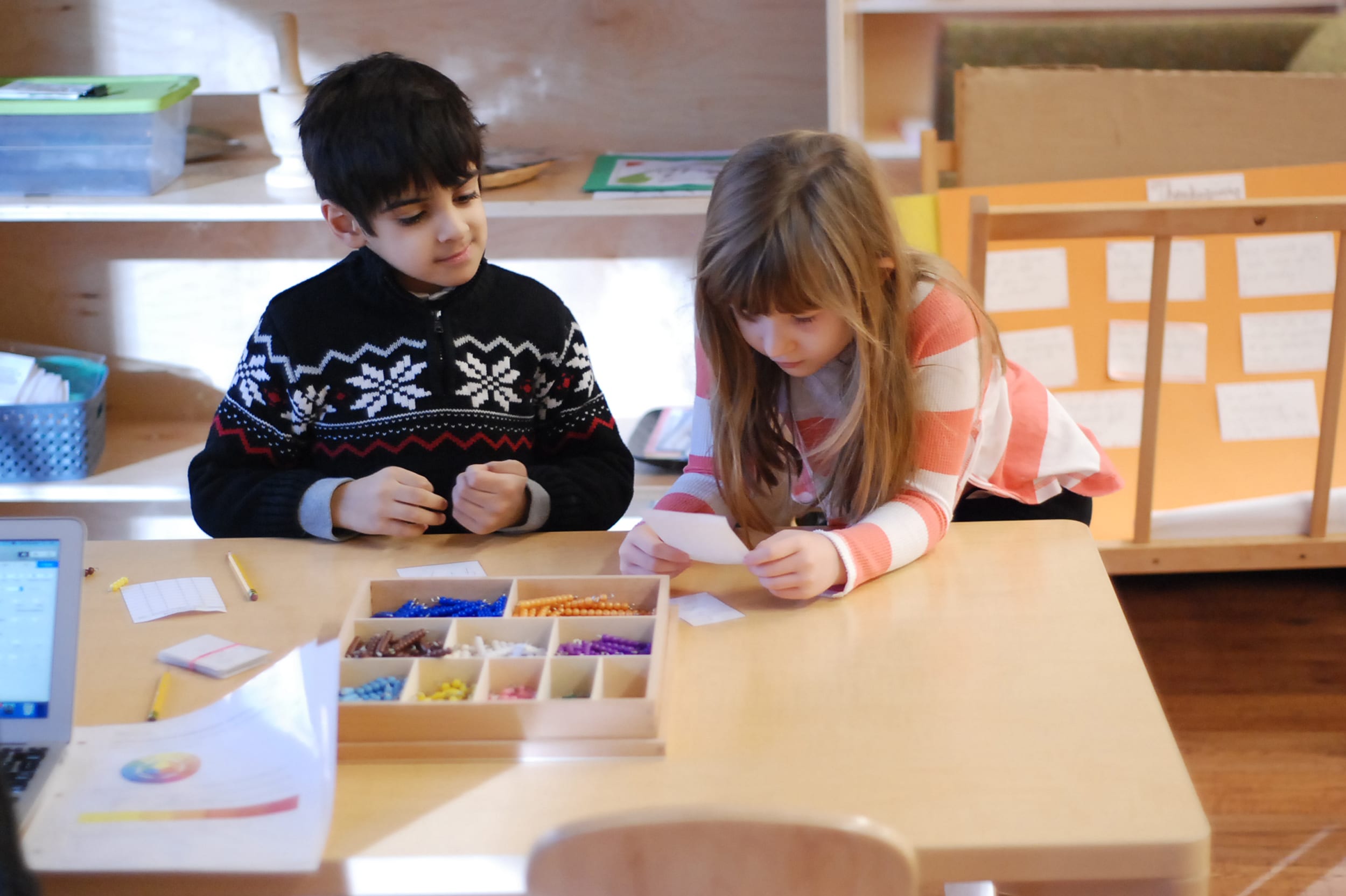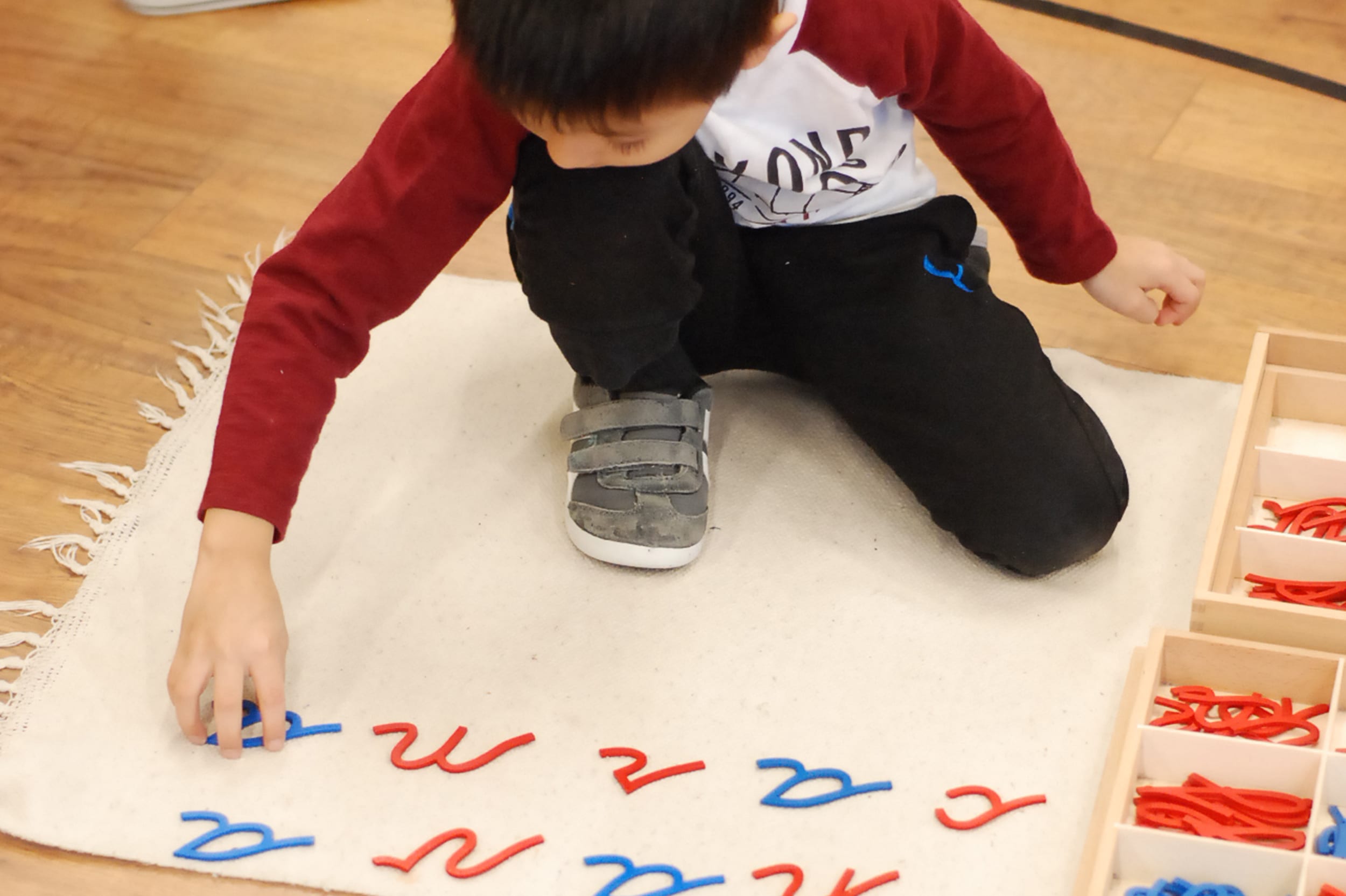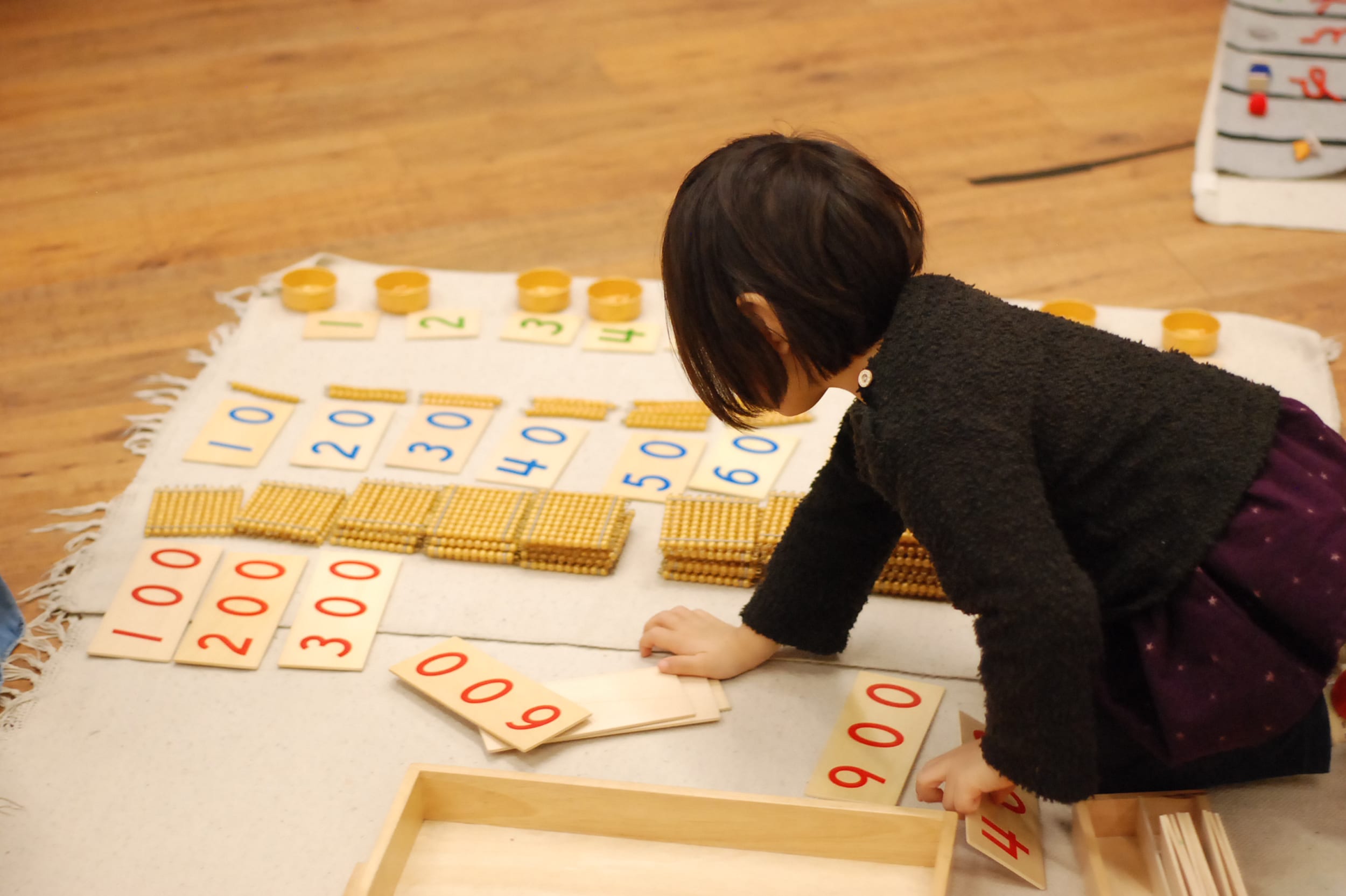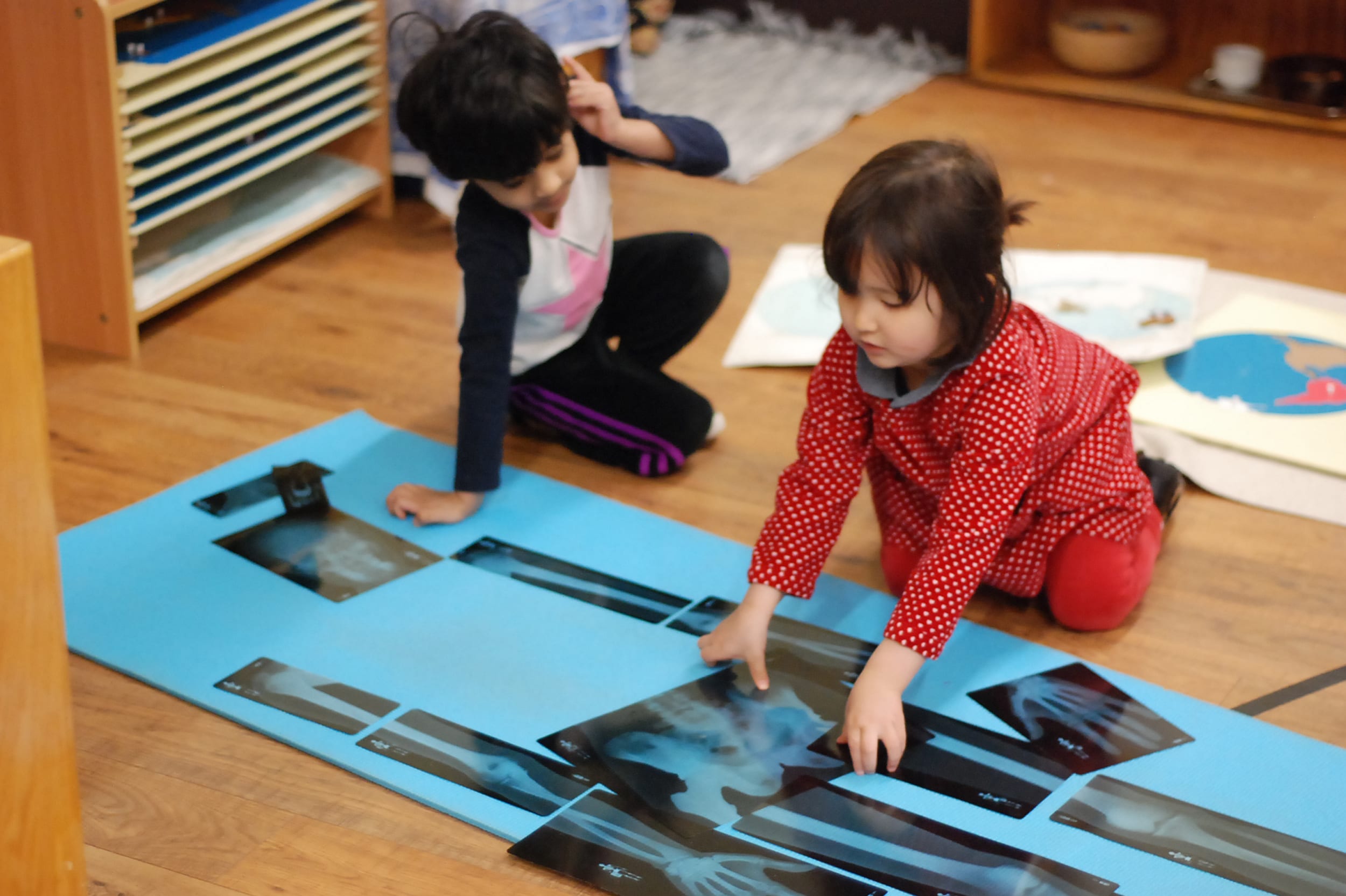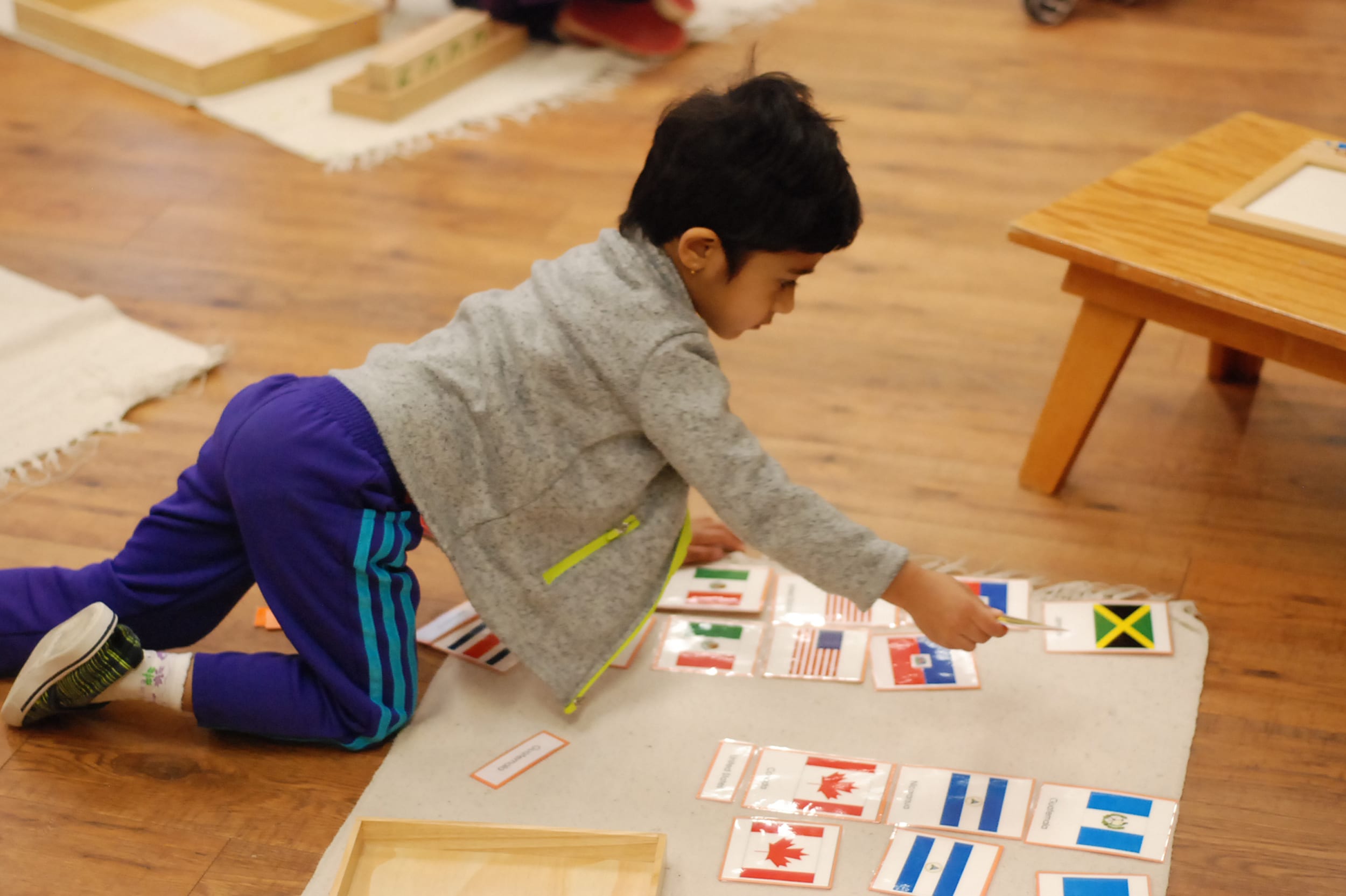Core Curriculum
Advanced Study Begins With Us.
Core Curriculum
Advanced Study Begins With Us.
American Montessori Academy students learn to think critically, work collaboratively, and act boldly — a skill set for the 21st century.
American Montessori Academy students learn to think critically, work collaboratively, and act boldly — a skill set for the 21st century.
The Montessori Curriculum is an integrated, thematic approach that ties the separate disciplines together into studies of the physical universe, the world of nature and the human experience.
Our Core Curriculum includes:
Practical Life
This is the area where the child may first choose independent work. The practical life area contains many attractively displayed objects familiar to the child, including a variety of items commonly used in the tasks of daily living, like eating, dressing, and cleaning. They offer the child meaningful, non-threatening modes of activity. The materials are also carefully designed and demonstrated to help teach skills involved with caring for the environment and the self, to encourage responsibility, autonomy and to promote high self-esteem.
This area of the curriculum is designed to invite the young learner to act and work on real life tasks that foster independence, coordination, order and concentration. It is in a sense the doorway to the Montessori curriculum.
This is the area where the child may first choose independent work. The practical life area contains many attractively displayed objects familiar to the child, including a variety of items commonly used in the tasks of daily living, like eating, dressing, and cleaning. They offer the child meaningful, non-threatening modes of activity. The materials are also carefully designed and demonstrated to help teach skills involved with caring for the environment and the self, to encourage responsibility, autonomy and to promote high self-esteem.
Sensorial
Children sort things by size, shape, color, touch, sound, temperature, smell, and by weight. Children grade from dark to light and from large to small. The Montessori Sensorial Materials are designed to aid the child in training and refining their five senses, allowing them to classify sensorial impressions in an organized, ordered and scientific manner.
These materials have been given many names: materialized abstractions, keys to the universe, paths to culture, etc. Regardless of the name, they are simple in appearance and totally satisfying to the child. Their particularity is that they allow the children to be spontaneous when facing each activity.
When children come into the world their first function is to adapt to their environment so that they may become a member of the human group and cultures to which they belong. The mechanism by which this occurs is one of absorption of all the elements surrounding them, obeying vital inner directions common to all children. What follows is what the Montessori Method proposes as experiential sensorial activities for opening intellectual growth.
Dr. Montessori discovered that by helping children to order, compare and classify sensory stimulation, their intellectual development was greatly assisted, and all future learning became more meaningful and useful.
Children sort things by size, shape, color, touch, sound, temperature, smell, and by weight. Children grade from dark to light and from large to small. The Montessori Sensorial Materials are designed to aid the child in training and refining their five senses, allowing them to classify sensorial impressions in an organized, ordered and scientific manner.
These materials have been given many names: materialized abstractions, keys to the universe, paths to culture, etc. Regardless of the name, they are simple in appearance and totally satisfying to the child. Their particularity is that they allow the children to be spontaneous when facing each activity.
When children come into the world their first function is to adapt to their environment so that they may become a member of the human group and cultures to which they belong. The mechanism by which this occurs is one of absorption of all the elements surrounding them, obeying vital inner directions common to all children. What follows is what the Montessori Method proposes as experiential sensorial activities for opening intellectual growth.
Grace & Courtesy
Through grace and courtesy lessons, we show how to move and respond to others. These lessons include grace in moving about the environment and the things and people they encounter, carrying things respectfully with special awareness and recognition. They also include courtesy in saying please and thank you, excusing themselves, waiting their turn, making a request, greeting a visitor or saying goodbye, etc.
All of these exercises cover the elements a child needs to know in order to feel comfortable and secure in dealing with others. They lead the child to develop respect for his or her environment and enable the child to learn how to be a contributing member of their community.
Grace and courtesy lessons are presented daily. Children are especially drawn to these activities because of their sensitive periods for learning precise movements and social skills, as well as their need to adapt and belong to their particular culture.
Through grace and courtesy lessons, we show how to move and respond to others. These lessons include grace in moving about the environment and the things and people they encounter, carrying things respectfully with special awareness and recognition. They also include courtesy in saying please and thank you, excusing themselves, waiting their turn, making a request, greeting a visitor or saying goodbye, etc.
All of these exercises cover the elements a child needs to know in order to feel comfortable and secure in dealing with others. They lead the child to develop respect for his or her environment and enable the child to learn how to be a contributing member of their community.
Language
With the Montessori Method, writing precedes reading, as the children explore with drawing and forming letters. A large variety of reading readiness materials are used, including materials for phonetic analysis, word attack skills and reading, as well as materials for the refinement of motor control for writing.
The child begins by exploring the sounds that compose words and by relating them to the letters of the alphabet. They soon can produce words and sentences free of all other mechanical difficulties. In the meantime, they train their hands to become precise and sure for the writing movements.
Reading is prepared indirectly from writing. The child starts from what they know about letters and the sounds, then they are assisted with the key to read all the words they encounter. This approach allows the process of learning how to read to be as painless and simple as learning how to speak. Reading skills normally develop so smoothly in Montessori classrooms that students tend to exhibit a sudden “reading explosion” which leaves the children and their families beaming with pride.
Language development is a priority of the entire Montessori classroom. Many other disciplines, as well as large group activities, foster vocabulary development, communication skills, writing and reading readiness.
With the Montessori Method, writing precedes reading, as the children explore with drawing and forming letters. A large variety of reading readiness materials are used, including materials for phonetic analysis, word attack skills and reading, as well as materials for the refinement of motor control for writing.
The child begins by exploring the sounds that compose words and by relating them to the letters of the alphabet. They soon can produce words and sentences free of all other mechanical difficulties. In the meantime, they train their hands to become precise and sure for the writing movements.
Reading is prepared indirectly from writing. The child starts from what they know about letters and the sounds, then they are assisted with the key to read all the words they encounter. This approach allows the process of learning how to read to be as painless and simple as learning how to speak. Reading skills normally develop so smoothly in Montessori classrooms that students tend to exhibit a sudden “reading explosion” which leaves the children and their families beaming with pride.
Mathematics
Students who learn math by rote method are often limited in their understanding or ability to apply skills to everyday life. Montessori students use hands-on learning materials that make abstract concepts clear and concrete.
The Montessori math curriculum introduces students to the study of the fundamentals of algebra, geometry, logic and statistics along with the principle of arithmetic. This study continues over the years, weaving together subjects that traditional schools normally ignore until the secondary grades.
The central purpose of the Math Materials in the early years is to lay the foundation for later cognitive development and to prepare for the gradual transition to abstract thinking. The primary values of these earlier activities in mathematics are found in the way they transform ideas into actions using concrete materials.
Students who learn math by rote method are often limited in their understanding or ability to apply skills to everyday life. Montessori students use hands-on learning materials that make abstract concepts clear and concrete.
The Montessori math curriculum introduces students to the study of the fundamentals of algebra, geometry, logic and statistics along with the principle of arithmetic. This study continues over the years, weaving together subjects that traditional schools normally ignore until the secondary grades.
Science
The Montessori approach to science cultivates children’s fascination with the universe and helps them to develop a lifelong interest in observing nature and discovering more about the world in which we live.
The scope of the Montessori science curriculum includes a sound introduction to botany, zoology, chemistry, physics, geology, and astronomy, with activities that may range from magnetism and weights to growing plants and classification of plants and animals.
Science is an integral element of the Montessori curriculum. Among other things, it represents a way of life: a clear thinking approach to gathering information and problem solving.
The Montessori approach to science cultivates children’s fascination with the universe and helps them to develop a lifelong interest in observing nature and discovering more about the world in which we live.
The scope of the Montessori science curriculum includes a sound introduction to botany, zoology, chemistry, physics, geology, and astronomy, with activities that may range from magnetism and weights to growing plants and classification of plants and animals.
Music, Creative Movement & Art
The most appealing musical element to young children is rhythm, and the natural response to rhythm is physical. The body is therefore the child’s first instrument through which the rhythms of music are reflected and interpreted. Children in the class are introduced to many songs and dance. Music will find its way in all aspects of the classroom – as a subtle background during work time, to signal clean-up time, as an integral part of the cultural curriculum and as a form of celebration and fun.
Creative Art is introduced through a variety of media including painting, drawing, and collage. Art history and appreciation are discussed as relevant to literature and cultural studies. Sensory training in color and design is encouraged using Montessori materials. Art in the primary environment strives to maintain the great joy the child finds in creating something of his or her own.
Music and movement education will also be important parts of the curriculum as well as the arts. They offer children ways to express themselves, their feelings, experiences and ideas.
The most appealing musical element to young children is rhythm, and the natural response to rhythm is physical. The body is therefore the child’s first instrument through which the rhythms of music are reflected and interpreted. Children in the class are introduced to many songs and dance. Music will find its way in all aspects of the classroom – as a subtle background during work time, to signal clean-up time, as an integral part of the cultural curriculum and as a form of celebration and fun.
Creative Art is introduced through a variety of media including painting, drawing, and collage. Art history and appreciation are discussed as relevant to literature and cultural studies. Sensory training in color and design is encouraged using Montessori materials. Art in the primary environment strives to maintain the great joy the child finds in creating something of his or her own.
History, Geography & Cultural Awareness
Cultural geography is the study of human society and culture. The children gain an awareness of the world around them by exploring other countries, their customs, food, music, climate, language and animals. These lessons, together, show the child that we are all members of the human race who must coexist peacefully in order to survive.
The fundamental human questions of self and understanding one’s place in the world are inherent in all of us. The youngest of children have a need to belong, to know they are safe, to understand their place in their immediate community – the family. It is within the confines of the family where the child first learns about their place in the universe. The rituals and routines of the family are absorbed unconsciously, allowing the child to later learn about and identify with other cultures. Using their senses, they expand beyond the family to discover the natural world.
This helps to raise their consciousness about other people, to gain an understanding and tolerance, and therefore, compassion for all the people in the world. Later in elementary school, the students see the world’s cultures in greater depth. They learn to treasure the richness of their own cultural heritage and those of their friends.
The Montessori Geography curriculum is two-fold: physical and cultural. Physical geography discusses the formation of the universe, the creation of the earth, and all of its physical properties. We introduce history and geography as early as age three. The youngest students work with specially designed maps and begin to learn the names of the world’s continents and countries.
Cultural geography is the study of human society and culture. The children gain an awareness of the world around them by exploring other countries, their customs, food, music, climate, language and animals. These lessons, together, show the child that we are all members of the human race who must coexist peacefully in order to survive.
The fundamental human questions of self and understanding one’s place in the world are inherent in all of us. The youngest of children have a need to belong, to know they are safe, to understand their place in their immediate community – the family. It is within the confines of the family where the child first learns about their place in the universe. The rituals and routines of the family are absorbed unconsciously, allowing the child to later learn about and identify with other cultures. Using their senses, they expand beyond the family to discover the natural world.
This helps to raise their consciousness about other people, to gain an understanding and tolerance, and therefore, compassion for all the people in the world. Later in elementary school, the students see the world’s cultures in greater depth. They learn to treasure the richness of their own cultural heritage and those of their friends.



